Jeanette IGNACIO and Tanushri ROY
Alice Lee Centre for Nursing Studies (ALCNS)
Jeanette and Tanushri take readers through their experience of using an online platform (LAMS) to run team-based learning (TBL) sessions for a core nursing course, sharing the rationale for using LAMS and describing the activities conducted before and during the session using this platform.
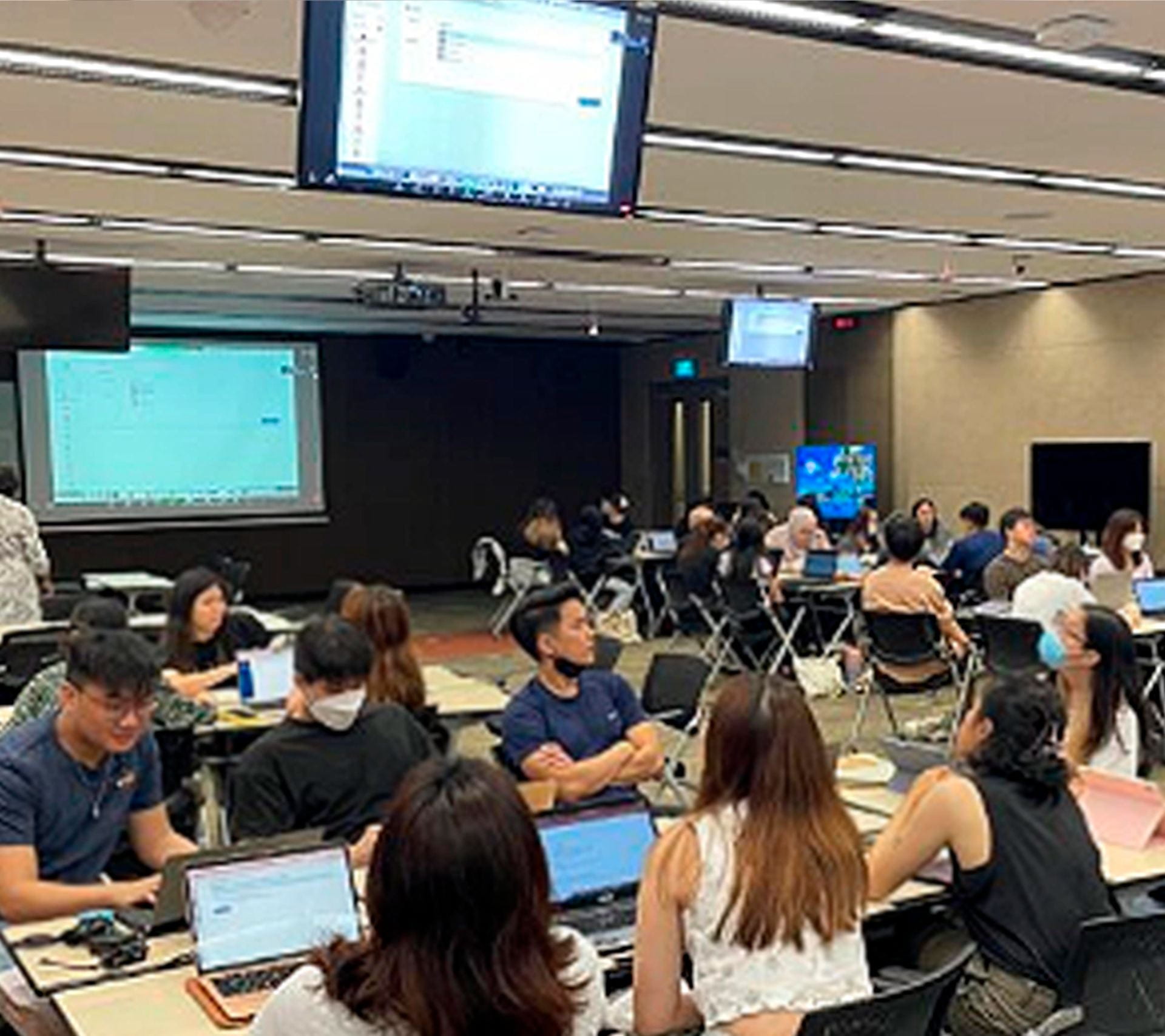 Students engaged in discussion using the team-based learning platform (photo provided by the authors).
Students engaged in discussion using the team-based learning platform (photo provided by the authors).
Ignacio, J., & Roy, T. (2023, October 28). Advantages and challenges of team-based learning (TBL) using a digital platform. Teaching Connections. https://blog.nus.edu.sg/teachingconnections/2023/10/28/advantages-and-challenges-of-team-based-learning-tbl-using-a-digital-platform/
Team-based learning (TBL) is considered a highly structured and evidence-based collaborative active learning strategy, which is targeted towards group learning sessions (McCoy et al., 2018). It is an instructor-led student-centred pedagogy delivered through several sequential phases. Students hold accountability for in-class and out-of-class preparation, and master course concepts by working collaboratively with peers under the instructor’s timely feedback (Sannathimmappa et al., 2022). The Alice Lee Centre for Nursing Studies (ALCNS) at NUS (also known as NUS Nursing) has, in some courses previously, implemented the traditional approach to the TBL pedagogy. With the onset of COVID-19, however, face-to-face teaching and learning modes were re-evaluated and modified to adapt to the changed educational milieu dictated by the pandemic. As traditional TBL use required face-to-face interactions, an alternative approach to the TBL pedagogy was necessary. The teaching team at NUS Nursing thus started exploring various online sources. A digital platform for TBL was then piloted for students enrolled in an integrated core course, NUR2125 “Pathophysiology, Pharmacology & Nursing Practice II”.
Traditional TBL Sessions at NUS Nursing (Pre-COVID)
TBL used to be taught in three phases: pre-class preparation, in-class readiness assurance testing (individual), and in-class readiness assurance testing (Team-Based Learning, 2011). The pre-class preparation phase occurred before the in-class TBL session. Students would study pre-reading materials sent by the instructor in advance or attend flipped classroom lectures beforehand. This allowed them to identify key learning issues in preparation for the activity. During the in-class TBL sessions, students were organised into teams of 5-6 members each. Individual student’s knowledge of the topic—gained through pre-class preparation—would be tested by the individual readiness assurance test (iRAT) closed book. After iRAT completion, students worked together on the same set of questions using the team readiness assurance test (tRAT) (Figure 1). During the tRAT, students discussed the answers within their teams. Each team must reach a consensus of their tRAT answers based on the discussion. Each team leader then submits their team’s final answer. The instructor provides immediate feedback on their answers and ensures that concepts pertinent to the topic are clear to learners.
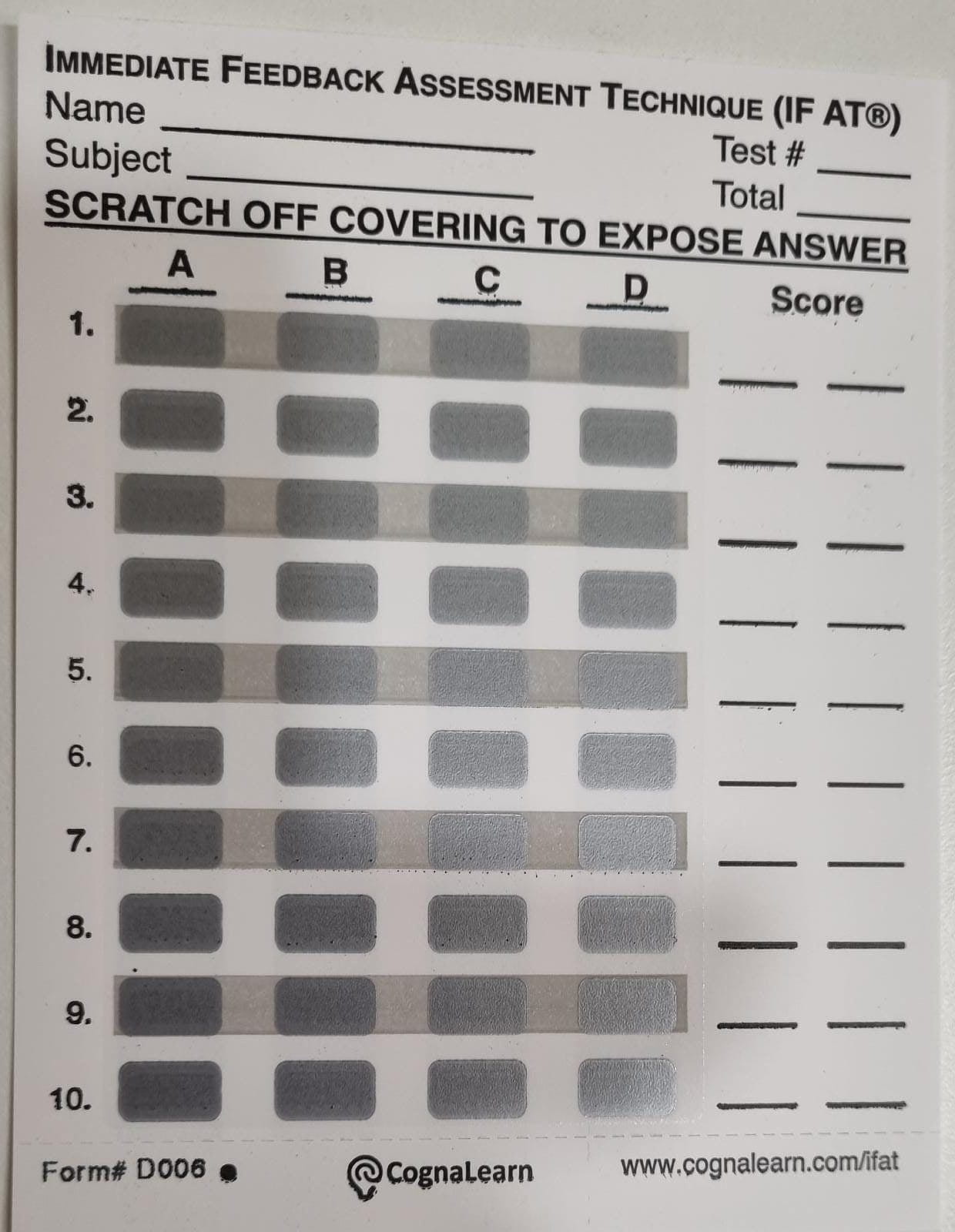
TBL Sessions at NUS Nursing Using the Online Platform (LAMS)
The online TBL pilot session aimed to tap into each student’s knowledge and understanding of a particular topic, by testing their knowledge and the application of that knowledge to a case study. The session was carried out in four phases on the Learning Activity Management System (LAMS) platform: iRAT, tRAT, application-based exercise using a case study, and instructors’ feedback (Koh, et al., 2022). Students were randomly assigned into groups. They began with tests to prepare themselves with the case, followed by learning how to apply concepts to real-life conditions, and finally, individual reflection, on both the pedagogy and case management process of each session. The same format was used for every session.
The structured flow of activities for each session on the LAMS platform are described as follows, and also reflected in Figures 2 and 4:
Before the Session
- Introduction. A training session is conducted for the students and staff on TBL and the TBL workflow
- Team Formation. Students are randomly assigned to groups.
During the Session
- Gate. This allows facilitators to control when the students can begin an activity. Opened gates prompt students to take the next step in the learning path during the lesson.
- iRAT (Individual Readiness Assurance Test). Students individually complete the readiness assurance test.
- Leader Selection. A leader is chosen by the group and this team leader will select the tRAT answers on the team’s behalf. The leader gets the team consensus, encourages the team members to participate and keeps track of time (Figure 3).
- tRAT (Team Readiness Assurance Test). This consists of the same questions as the iRAT but answered as a team. The team leader answers questions on the team’s behalf and raises challenges or burning questions for clarification or elaboration.
- Instructor Feedback (Burning Questions). Facilitators clarify all doubts and misconceptions regarding questions raised by the students.
- Application Exercises (AEs). The AEs are real and authentic cases where students, in their own teams, apply and expand on the knowledge they have learned and which was tested previously in the iRAT and tRAT.
- Final Reflection. Students reflect on the key learning points covered during the lesson. These reflections aim to solidify key learning concepts which can be reviewed as preparation for students’ assessments/exams.

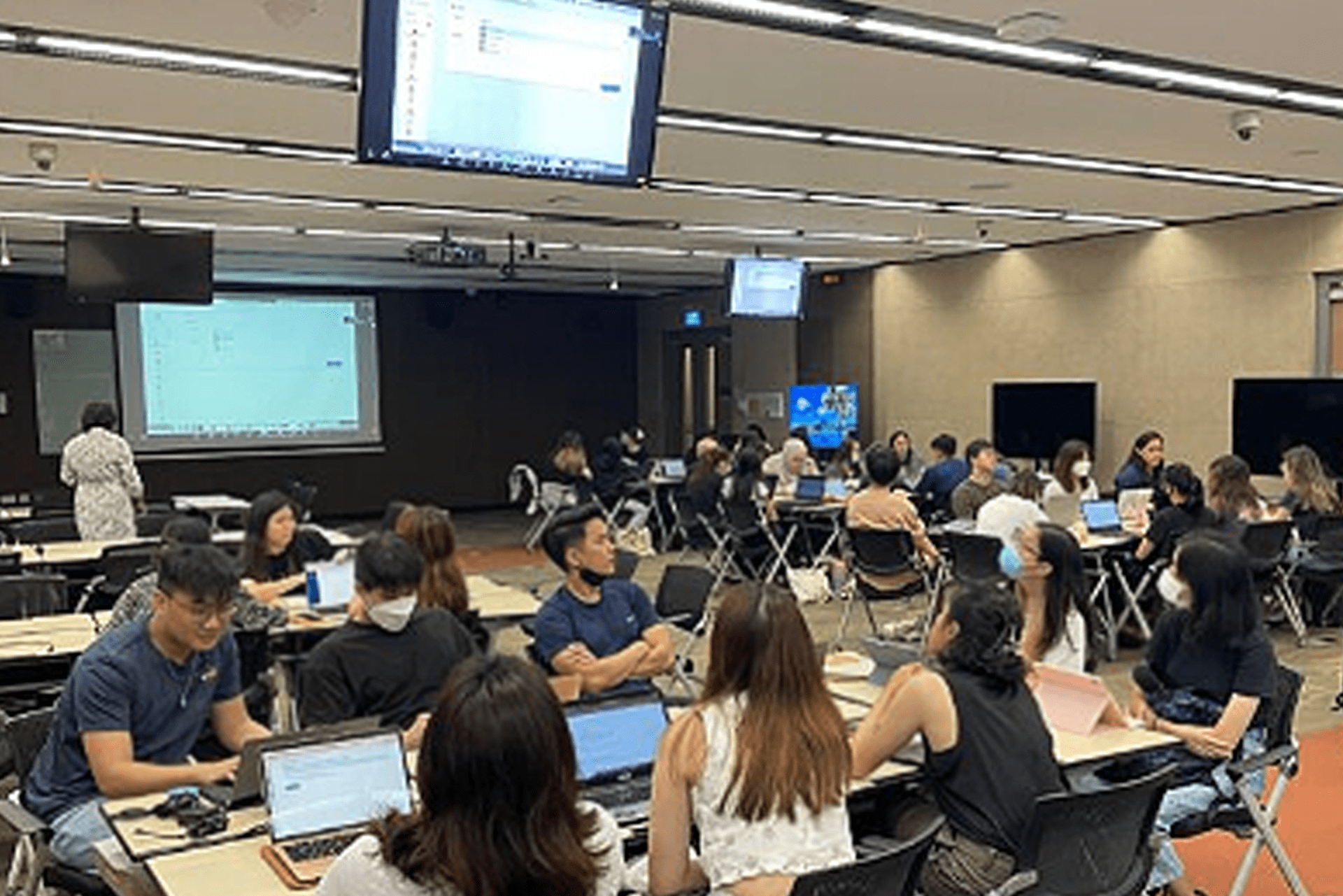
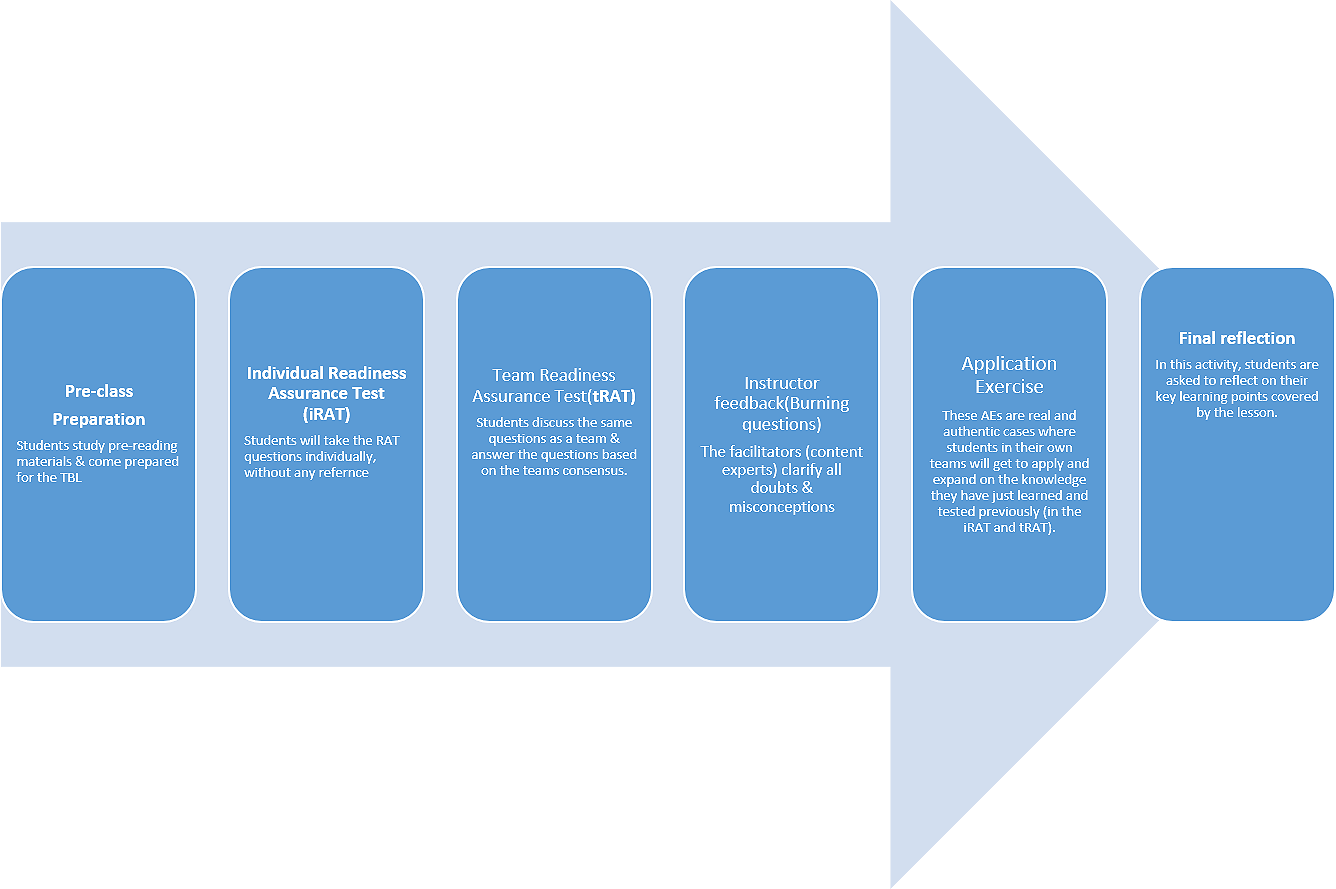
Feedback on Using the Pedagogy and Digital Platform
Both facilitators and students enjoyed the TBL sessions thoroughly, based on the feedback provided:

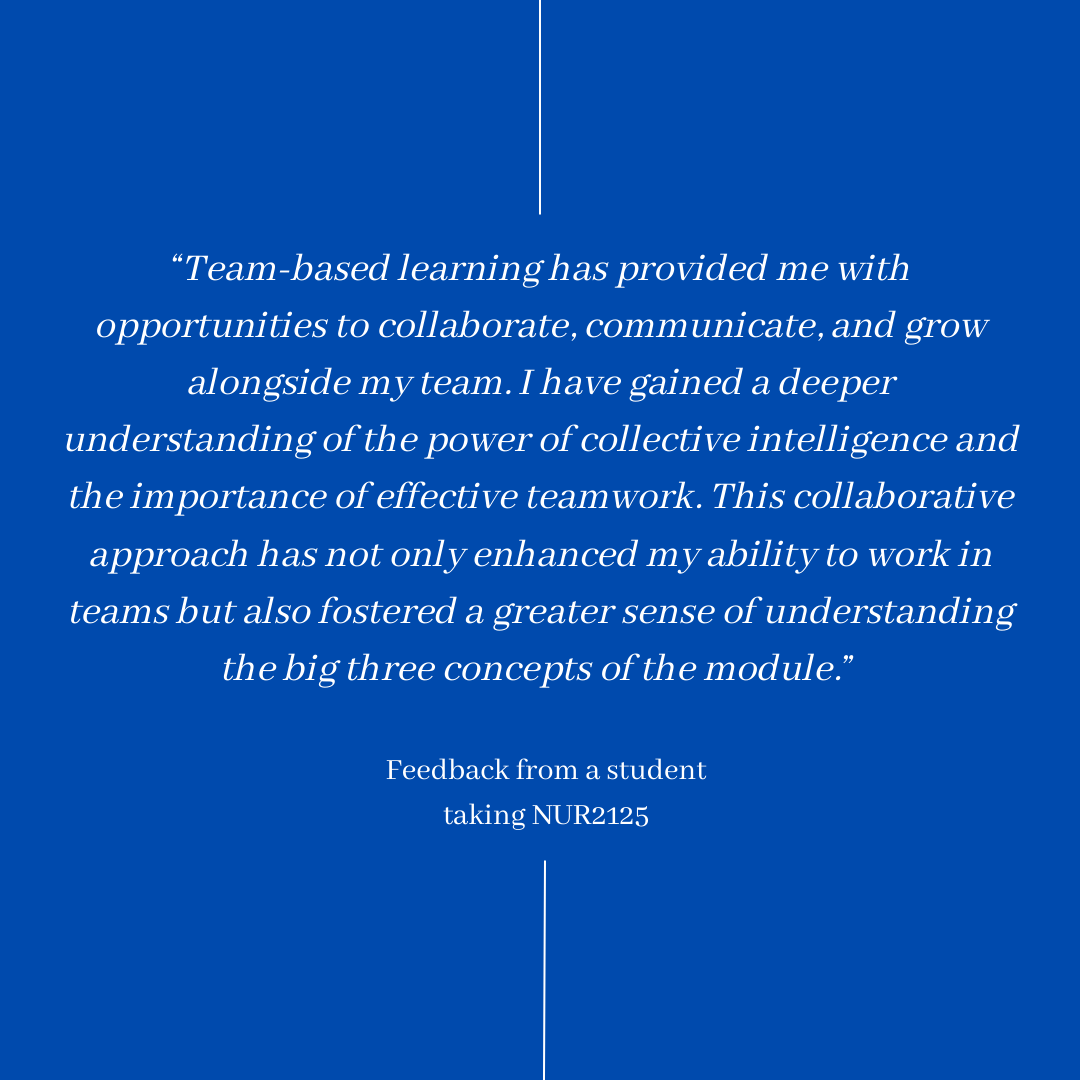
Concluding Reflections
After implementing the online TBL pilot session for NUR2125 and collecting feedback, the teaching team made the following observations:
Advantages of Using Online TBL Platform
The online TBL platform is more beneficial than the traditional TBL approach in several ways. First, this activity is entirely virtual, which means students can participate in an online or hybrid platform. This gives the platform an advantage over the traditional one, as the online platform becomes necessary in situations when face-to-face interactions are impossible, such as during the COVID-19 pandemic.
Second, using the online TBL platform means the teaching team can observe student dynamics and analyse how well each student understands the topic. As facilitators can now observe and monitor student activity in real time on the online platform, they can identify students who might experience difficulties with the topic, as evidenced by a change in their answer when discussing in teams with their peers. Third, it is a good platform for peer review as well by evaluating the feedback analytics. Finally, the online format promotes a reduction of paper waste given the paperless nature of the learning activity.
Challenges Faced
The teaching team also noted some challenges to using the online TBL platform, which will be taken into consideration for the next iteration of the course. First, the teaching staff, administration support staff, and students need basic training to understand TBL concepts. Familiarisation with the online platform is a must. Cost is also a factor, as using an online platform designed by an external vendor can potentially be expensive. Finally, we need to be very careful about sharing student data with external vendors. During the pilot, dummy names for all the students were created and they were given a generic email by the vendor to be logged into the system.
Nonetheless, the teaching team agreed that there is value in implementing the online TBL platform, and would encourage NUS colleagues to consider applying it in their practice. NUS colleagues can contact us if they need any support or training in TBL.
References
Lams International (n. d.). Lams International. https://www.lamsinternational.com/
McCoy, L., Pettit, R. K., Kellar, C., & Morgan, C. (2018). Tracking active learning in the medical school curriculum: A learning-centered approach. J Med Educ Curric Dev, 5, 2382120518765135. https://doi.org/10.1177%2F2382120518765135
Sannathimmappa, M. B., Nambiar, V., Aravindakshan, R., & Kumar A. (2022). Are online synchronous team-based-learning (TBL) pedagogy effective? Perspectives from a study on medical students in Oman. J Adv Med Educ Prof, 10(1), 12-21. https://doi.org/10.30476/jamp.2021.92361.1481
Serin, H. (2018). A comparison of teacher-centered and student-centered approaches in educational settings. International Journal of Social Sciences & Educational Studies, 5(1), 164–7. http://dx.doi.org/10.23918/ijsses.v5i1p164
Team-based learning (2011). Medical Science Educator, 21(4), 385-7. https://doi.org/10.1007/bf03341741
 |
Tanushri ROY is a Senior Lecturer at the Alice Lee Centre for Nursing Studies (ALCNS). Having a medical degree allows Dr Tanushri to mentor nursing students and allied health students in areas such as anatomy, physiology and pathophysiology. She employs a range of pedagogies such as blended learning, problem-based learning, team exercises, proper use of Learning Management Systems and traditional teaching, in her instruction. Her research interests include educational leadership, patient safety and community medicine. She has successfully conducted various healthcare projects funded by organisations such as the World Bank. Tanushri can be reached at nurtr@nus.edu.sg. |
 |
Jeanette IGNACIO is an Associate Professor at ALCNS, and is currently the Programme Director for the Year 1 Bachelor of Science (Nursing) Undergraduate Programme. Having practiced as an anesthesiologist with a PhD in medical education sparked her interest to attend formal courses in simulations. Hence, she was one of the first few at NUS to utilise high-fidelity simulations in her pedagogy, and has successfully incorporated this strategy in the postgraduate critical care modules she had coordinated. Subsequently, she also applied simulation-based learning to the undergraduate courses that she has taught. Jeanette has also published simulation and health professions education-related research in high-impact peer-reviewed journals and has presented her research findings in reputable international medical, nursing and health professions education conferences in Europe and the United States. Jeanette can be reached at nurimjj@nus.edu.sg. |

